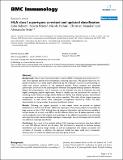| dc.contributor.author | Sidney, John | |
| dc.contributor.author | Peters, Bjoern | |
| dc.contributor.author | Frahm, Nicole | |
| dc.contributor.author | Brander, Christian | |
| dc.contributor.author | Sette, Alessandro | |
| dc.date.accessioned | 2011-11-01T14:41:05Z | |
| dc.date.issued | 2008 | |
| dc.identifier.citation | Sidney, John, Bjoern Peters, Nicole Frahm, Christian Brander, and Alessandro Sette. 2008. HLA class I supertypes: a revised and updated classification. BMC Immunology 9: 1. | en_US |
| dc.identifier.issn | 1471-2172 | en_US |
| dc.identifier.uri | http://nrs.harvard.edu/urn-3:HUL.InstRepos:5333510 | |
| dc.description.abstract | Background: Class I major histocompatibility complex (MHC) molecules bind, and present to T cells, short peptides derived from intracellular processing of proteins. The peptide repertoire of a specific molecule is to a large extent determined by the molecular structure accommodating so-called main anchor positions of the presented peptide. These receptors are extremely polymorphic, and much of the polymorphism influences the peptide-binding repertoire. However, despite this polymorphism, class I molecules can be clustered into sets of molecules that bind largely overlapping peptide repertoires. Almost a decade ago we introduced this concept of clustering human leukocyte antigen (HLA) alleles and defined nine different groups, denominated as supertypes, on the basis of their main anchor specificity. The utility of this original supertype classification, as well several other subsequent arrangements derived by others, has been demonstrated in a large number of epitope identification studies. Results: Following our original approach, in the present report we provide an updated classification of HLA-A and -B class I alleles into supertypes. The present analysis incorporates the large amount of class I MHC binding data and sequence information that has become available in the last decade. As a result, over 80% of the 945 different HLA-A and -B alleles examined to date can be assigned to one of the original nine supertypes. A few alleles are expected to be associated with repertoires that overlap multiple supertypes. Interestingly, the current analysis did not identify any additional supertype specificities. Conclusion: As a result of this updated analysis, HLA supertype associations have been defined for over 750 different HLA-A and -B alleles. This information is expected to facilitate epitope identification and vaccine design studies, as well as investigations into disease association and correlates of immunity. In addition, the approach utilized has been made more transparent, allowing others to utilize the classification approach going forward. | en_US |
| dc.language.iso | en_US | en_US |
| dc.publisher | BioMed Central | en_US |
| dc.relation.isversionof | doi://10.1186/1471-2172-9-1 | en_US |
| dc.relation.hasversion | http://www.ncbi.nlm.nih.gov/pmc/articles/PMC2245908/pdf/ | en_US |
| dash.license | LAA | |
| dc.title | HLA Class I Supertypes: A Revised and Updated Classification | en_US |
| dc.type | Journal Article | en_US |
| dc.description.version | Version of Record | en_US |
| dc.relation.journal | BMC Immunology | en_US |
| dash.depositing.author | Brander, Christian | |
| dc.date.available | 2011-11-01T14:41:05Z | |
| dash.affiliation.other | HMS^Medicine-Massachusetts General Hospital | en_US |
| dc.identifier.doi | 10.1186/1471-2172-9-1 | * |
| dash.contributor.affiliated | Brander, Christian | |


